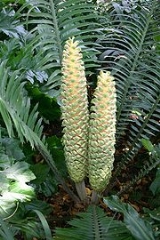
Encephalartos villosus
Encyclopedia
Encephalartos villosus is a South Africa
n cycad
occurring from the East London vicinity, where it is found near the coast, to the northern border of Swaziland
where it may grow as far as 100 km inland. The species is common throughout its range and is the most frequently cultivated in Southern Africa, largely because of its affordable price. As a result of its large geographical distribution, it is notably variable in leaf and cone shape.
A largely underground trunk results in very little of the plant being visible, so that it is described as a dwarf species. The preferred habitat of this species is frost-free coastal bush. It hybridises readily with Encephalartos altensteinii
in the Eastern Cape
and with Encephalartos lebomboensis in the Pongola area.
The crown normally consists of tightly-packed bracts covered in dense grey woolly hair (villosus = hairy). As with all cycads this species is dioecious
. Male plants may carry up to 15 cones, whereas only one or two occur on the females. The seeds, embedded in bright-red flesh are eaten and distributed by the Purple-crested Lourie (Tauraco porphyreolophus) and by the Trumpeter Hornbill (Bycanistes bucinator).
South Africa
The Republic of South Africa is a country in southern Africa. Located at the southern tip of Africa, it is divided into nine provinces, with of coastline on the Atlantic and Indian oceans...
n cycad
Cycad
Cycads are seed plants typically characterized by a stout and woody trunk with a crown of large, hard and stiff, evergreen leaves. They usually have pinnate leaves. The individual plants are either all male or all female . Cycads vary in size from having a trunk that is only a few centimeters...
occurring from the East London vicinity, where it is found near the coast, to the northern border of Swaziland
Swaziland
Swaziland, officially the Kingdom of Swaziland , and sometimes called Ngwane or Swatini, is a landlocked country in Southern Africa, bordered to the north, south and west by South Africa, and to the east by Mozambique...
where it may grow as far as 100 km inland. The species is common throughout its range and is the most frequently cultivated in Southern Africa, largely because of its affordable price. As a result of its large geographical distribution, it is notably variable in leaf and cone shape.
A largely underground trunk results in very little of the plant being visible, so that it is described as a dwarf species. The preferred habitat of this species is frost-free coastal bush. It hybridises readily with Encephalartos altensteinii
Encephalartos altensteinii
Encephalartos altensteinii is a palm-like cycad in the family Zamiaceae. It is endemic to South Africa. The species name altensteinii commemorates Altenstein, a 19th century German chancellor and patron of science. It is commonly known as the breadtree, broodboom, eastern Cape giant cycad or uJobane...
in the Eastern Cape
Eastern Cape
The Eastern Cape is a province of South Africa. Its capital is Bhisho, but its two largest cities are Port Elizabeth and East London. It was formed in 1994 out of the "independent" Xhosa homelands of Transkei and Ciskei, together with the eastern portion of the Cape Province...
and with Encephalartos lebomboensis in the Pongola area.
The crown normally consists of tightly-packed bracts covered in dense grey woolly hair (villosus = hairy). As with all cycads this species is dioecious
Dioecious
Dioecy is the property of a group of biological organisms that have males and females, but not members that have organs of both sexes at the same time. I.e., those whose individual members can usually produce only one type of gamete; each individual organism is thus distinctly female or male...
. Male plants may carry up to 15 cones, whereas only one or two occur on the females. The seeds, embedded in bright-red flesh are eaten and distributed by the Purple-crested Lourie (Tauraco porphyreolophus) and by the Trumpeter Hornbill (Bycanistes bucinator).

